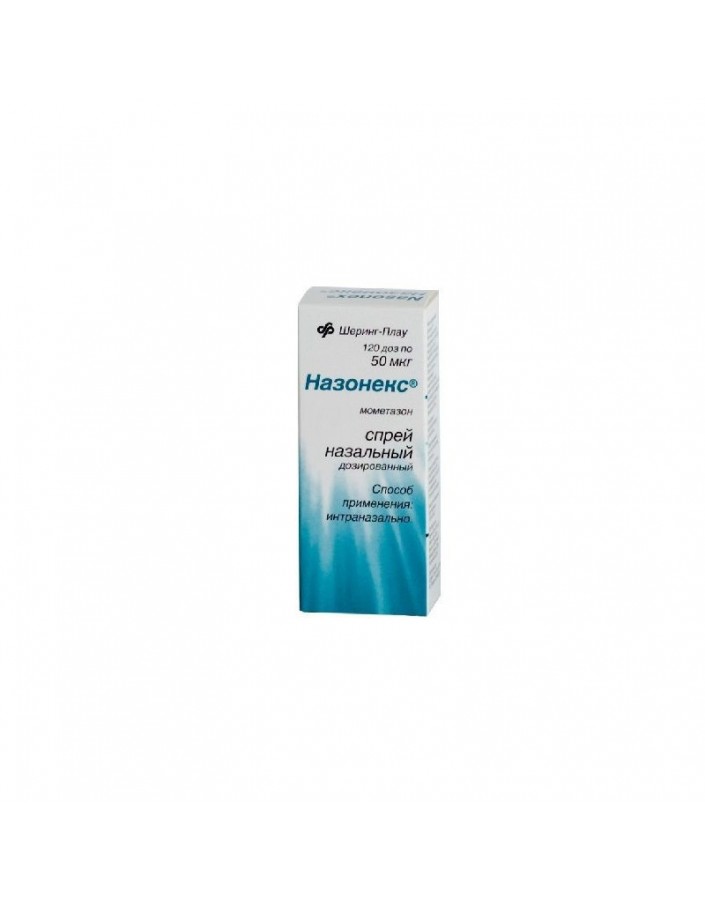




Security policy (edit with Customer reassurance module)

Delivery policy (edit with Customer reassurance module)

Return policy (edit with Customer reassurance module)
Bottle of 120 doses.
Nasonex - GCS for intranasal use. It has anti-inflammatory and anti-allergic effect. The local anti-inflammatory effect of the drug is manifested when it is used in doses that do not cause systemic effects.
Treatment of allergic rhinitis (seasonal and year-round) in adults, adolescents and children from 2 years; exacerbation of sinusitis (complex therapy with antibiotics) in adults (including old age) and children from 12 years old; prevention of moderate-to-severe seasonal allergic rhinitis (recommended 2–4 weeks before the expected start of the dusting season).
Hypersensitivity to any component of the drug; the presence of untreated local infection with involvement in the process of the nasal mucosa; recent surgery or injury to the nose (up towound healing); tuberculous infection (active or latent) of the respiratory tract, untreated fungal, bacterial, viral systemic infection or infection caused by Herpes simplex c eye damage (as an exception, the prescription of the drug in these cases is possible as directed by the doctor with great caution); children's age up to 2 years (there are no data on safety of use).
After intranasal use of the drug in the maximum therapeutic dose, mometasone is not detected in the blood plasma, even at the minimum concentration; therefore, it can be expected that its effect on the fetus will be negligible, and the potential toxicity in relation to reproductive function - very low. However, due to the fact that special, well-controlled studies of the drug's action in pregnant women have not been performed. Nasonex should be prescribed to pregnant women, mothers who are breastfeeding or women of childbearing age only if the expected benefit from his appointment justifies the potential risk to the fetus and newborn. Newborns whose mothers used GCS during pregnancy should be carefully examined to identify possible adrenal hypofunction.
Intranasal. Nasonex is used as an intranasal inhalation of a suspension contained in a spray vial. Inhalations are carried out using a special dispensing nozzle on the bottle.Before using the nasal spray nasal spray for the first time, it is necessary to “calibrate” it by pressing the dosing device 6–7 times. After “calibration”, a stereotypical drug supply is established, with each button press releasing approximately 100 mg of mometasone furoate suspension containing mometasone furoate monohydrate in an amount equivalent to 50 μg of chemically pure mometasone furoate. If the nasal spray has not been used for 14 days or longer, re-“calibration” is necessary before new use. Before each use, vigorously shake the spray bottle.
Treatment of seasonal or year-round allergic rhinitisadults (including senile age) and teenagers from 12 years usually the recommended prophylactic and therapeutic dose of the drug is 2 inhalations (50 mcg each) in each nostril, once (total daily dose of 200 mcg). After achieving the desired therapeutic effect for maintenance therapy, it is advisable to reduce the dose to 1 inhalation in each nostril 1 time per day (total daily dose 100 μg).
If the reduction of the symptoms of the disease could not be achieved by using the drug at the recommended therapeutic dose, the daily dose may be increased to 4 inhalations in each nostril 1 time per day (total daily dose 400 mcg). After reducing the symptoms of the disease, a dose reduction is recommended.The onset of action of the drug is usually marked clinically within the first 12 hours after the first use of the drug.
Children 2–11 years old:The recommended therapeutic dose is 1 inhalation (50 mcg) in each nostril once a day (total daily dose is 100 mcg).
Forof treating exacerbations of chronic sinusitis as part of complex therapy with antibiotics Adults (including seniors) and children from 12 years old are prescribed 100 mcg (2 injections) in each nostril 2 times a day.
Auxiliary treatment of sinusitis exacerbations Adults (including seniors) and adolescents from 12 years of age: the recommended therapeutic dose is 2 inhalations (50 mcg) in each nostril 2 times a day (total daily dose 400 mcg). The total daily dose is 400 micrograms.
In the treatment of seasonal or year-round allergic rhinitis. In adults: - nasal bleeding (obvious or discharge of blood-stained mucus or blood clots) - pharyngitis, - burning sensation in the nose, - irritation of the nasal mucosa. Nosebleeds, as a rule, stopped on their own, were not heavy; they occurred with a frequency slightly higher than when using placebo (5%), but equal to or less than using other GCS for intranasal use, which were used as an active control (for some of them, the incidence of nasal bleeding was up to 15% ). The incidence of all other adverse events was comparable to the frequency of their occurrence when placebo was prescribed. In children: - nosebleeds, - headache, - sensation of irritation in the nose, - sneezing.The incidence of these adverse events in children was comparable to the frequency of their occurrence with placebo. In the treatment of exacerbations of sinusitis (when using Nasonex spray as an aid). In adults and adolescents: - headache, - pharyngitis, - burning sensation in the nose, - irritation of the nasal mucosa. Nosebleeds were moderately pronounced, the frequency of their occurrence when using Nasonex was also comparable to the frequency of nosebleeds when using placebo (5% versus 4%, respectively). Very rarely, with intranasal GCS, there were cases of perforation of the nasal septum or an increase in intraocular pressure.
In the dark place at a temperature of no higher than 25 ° C.